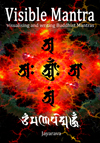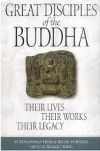The verses from the vinaya beginning "ye dharmā hetuprabhava" are the words spoken by the Arahant Assaji (Sanskrit: Aśvajit) to Upatissa, later to become known as Sariputta (Sanskrit: Śariputra). Sariputta along with his boyhood companion Kolita, later called Moggallāna (Sanskrit: Maudgalyayana), was one of the two chief disciples of the Buddha. Upon meeting Assaji, Sariputta was impressed and asked after his teacher and the dhamma that he taught. Assaji demurred, being "only a beginner", but eventually responded with the now famous verse, and before he had finished Sariputta had a decisive break through. Nyanaponika says:
"Upon hearing the first two lines, there arose in the wanderer Upatissa the dust-free, stainless vision of the Dhamma - the first glimpse of the Deathless, the path of Stream-entry - and to the ending of the last two lines he already listened as a stream-enterer".
- Great Disciples of the Buddha
by Hellmuth Hecker &
Nyanaponika Thera
Sanskrit
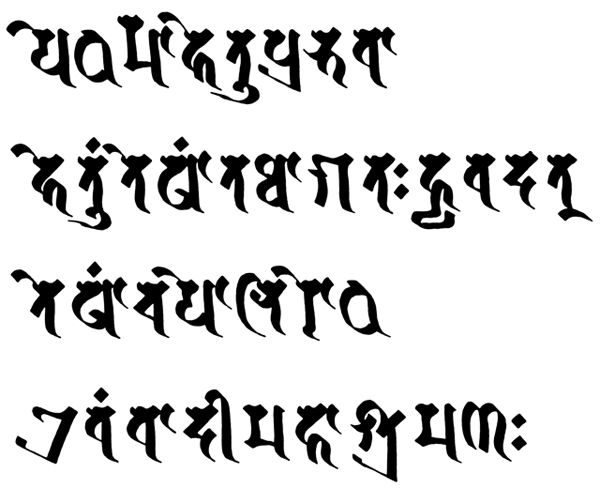
Transliteration
|
Ye dha rmā he tu pra bha vā |
ये धर्मा हेतु प्रभवा |
Ye dharmā hetuprabhavā hetuṃ teṣāṃ tathāgataḥ hyavadat teṣāṃ ca yo nirodha evaṃ vādī mahāśramaṇaḥ
ये धर्मा हेतु प्रभवा हेतुं तेषां तथागतः ह्यवदत् तेषां च यो निरोध एवं वादी महाश्रमणः
Lantsa
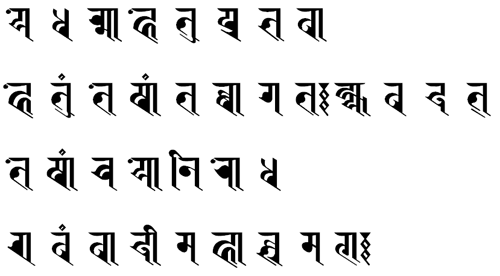

The Ye Dharma mantra in a cursive form of the Lantsa script from the verso of a Tibetan thangka

The Ye Dharma mantra in semi-formal (sort of sans-serif) Lantsa script from the verso of a Tibetan thangka

The Ye Dharma mantra in a formal version of the Lantsa script from the verso of a Tibetan thangka
My thanks to Amy Heller, author of Tibetan Art, for these images of the Lantsa script.
Tibetan (Uchen)
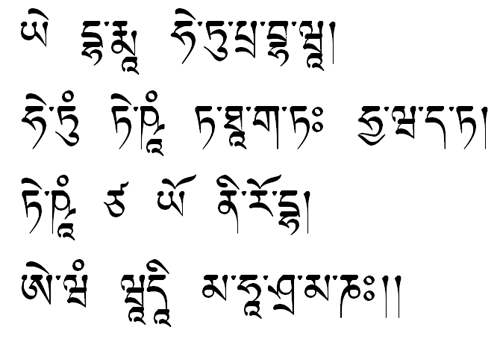
Ye dharma in Sanskrit transliterated into the Tibetan Uchen script
Translation
|
A Standard Translation
Of those things that arise from a cause, |
Alternative Translation
Of those experiences that arise from a cause |
Pāli - Sinhala Script
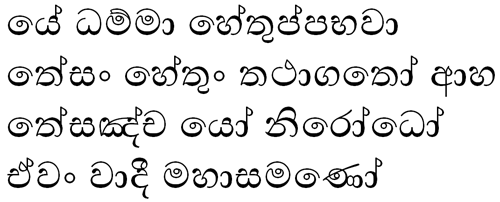
Transliteration
Ye dhammā hetuppabhavā
tesaṃ hetuṃ tathāgato āha,
tesañca yo nirodho
evaṃ vādī mahāsamaṇo
Comments
This verse has been referred to a kind of Buddhist credo (Latin for: I believe). It is very commonly seen inscribed on statues of the Buddha, or on the backs of paintings (see above). That "things" arise in dependence on causes, and cease when the causes are no longer present is taken not as a statement of faith by Buddhists, but as a statement of empirical truth; a fact which may be confirmed through observation. Buddhists do no follow the Christian idea: "credo quia absurdum est" - I believe it because it is unreasonable. Belief, if it is to be at all relevant, must be verifiable.
The "things" refered to are in fact dharmas (Pāli dhamma) which are mental phenomena - the experience of a thing through the senses and the mind, rather than actual objects themselves. The phrase is: "of those dharmas which arise from causes..." All knowledge of any "objective" reality is mediated through the senses and the mind, and therefore all knowledge is subjective. This does not deny the possibility of an objective reality, only that it can be known directly. In contemporary terms then, it is experience (the knowledge of dharmas) which arises from a cause, and ceases when the cause is no longer present. By claiming to know the origins of experience, the Buddha is not claiming omniscience, or indeed any knowledge of objective reality. His gnosis is related to the nature of experience, why experience is ultimately disappointing, ad what to do about it.

